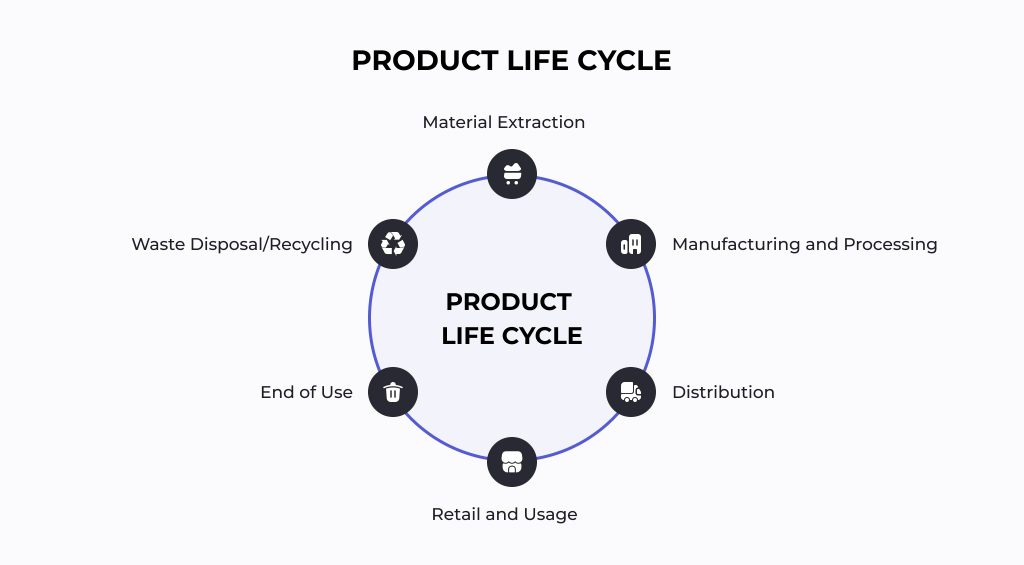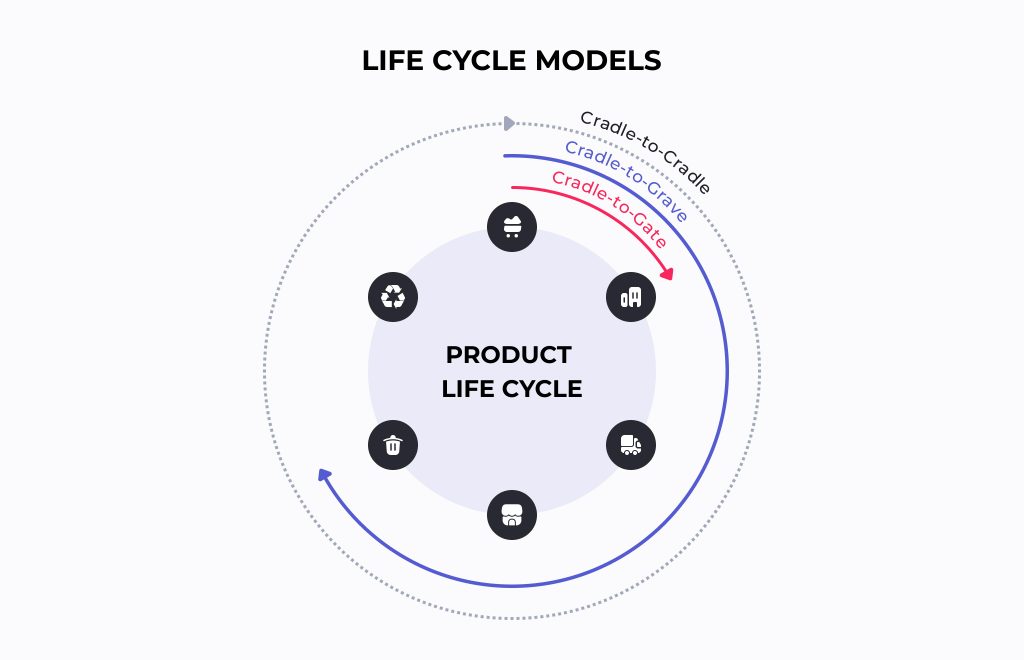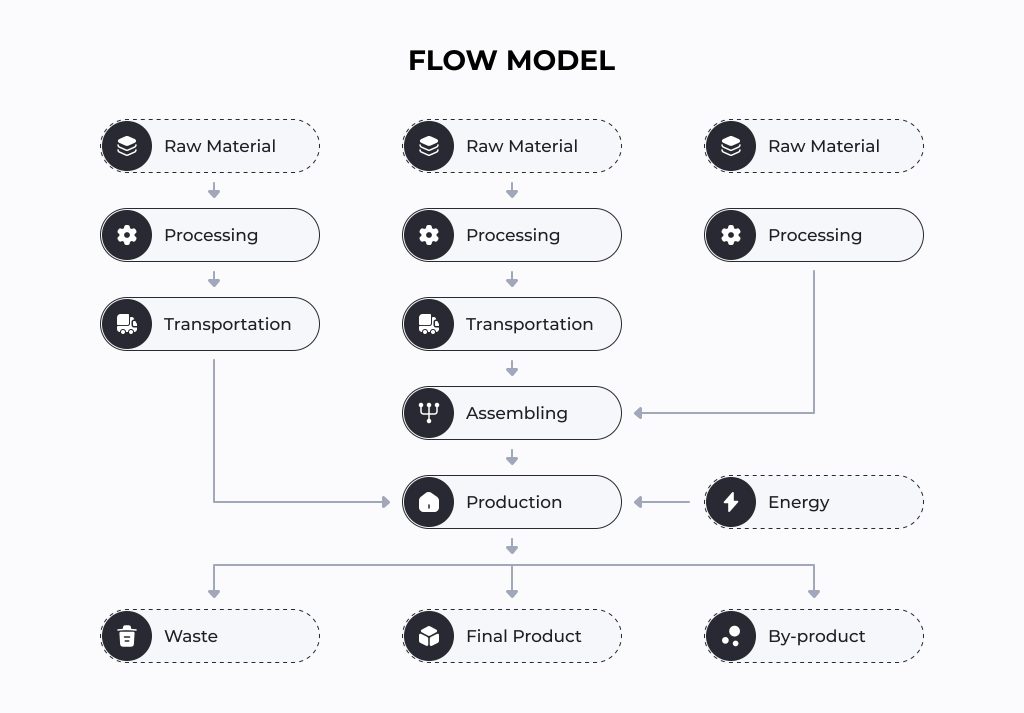Ensuring product sustainability has both global and local impacts. As the US Environmental Protection Agency points out, reducing waste and adopting reusing practices prevent pollution by minimizing the need to harvest new raw materials, saving energy, and reducing greenhouse gas emissions contributing to the global climate. Additionally, as a joint study from McKinsey and NielsenIQ shows, people are more likely to consume products that claim to be environmentally responsible.
Considering this, evaluating your business's environmental impacts and keeping them low not only helps save Mother Earth but also makes your product more attractive to potential consumers. So, it's a win-win situation. The question is, how exactly can you assess these factors? Life Cycle Assessment, or LCA, is the exact answer, and today, we'll look in detail at how it works.
What Is LCA and What Companies Need It?
Life Cycle Assessment (LCA) is an analysis technique that provides tools and frameworks for measuring and managing the footprint of a business's products and services. It embraces the whole life cycle, from raw materials extraction to waste disposal. Such an approach allows for measuring the cumulative effect of making a product since you can analyze every aspect of it, from where the raw materials come to how you deliver it and how it's recycled. To help you not get lost in all the indicators such a task may involve, LCA provides a framework describing the necessary sequence of actions that we'll discuss later.
Performing such an analysis is applicable in numerous industries. For example:
Manufacturers can optimize their production processes and choose more sustainable materials;
Construction firms can evaluate the environmental impact of building materials, such as concrete, steel, and others;
Logistics and transportation can evaluate the burdens of freight transport in product supply chains, such as the pollution that comes from different modes of transport (truck, rail, ship, etc.);
Agricultural producers can assess their farming practices, such as conventional vs. organic farming, for example;
Electronics companies can rely on LCA to design more eco-friendly devices;
Energy providers can compare the footprints of different electricity generation methods, such as fossil fuels, nuclear, and renewable energy sources.
Read Also Using the Power of the Earth’s Core. Geothermal Energy Advantages and Future Development
Within such companies, the insights that LCA can provide are primarily important for those departments that have a direct influence on the products and services provided: product management, research and development (R&D), supply chain management, procurement, marketing and sales, executive level, and strategic management.
LCA's versatility enables various specialized assessments, from carbon footprinting to social impact analysis. Whether a company requires a comprehensive, ISO-compliant study or a more focused, single-issue analysis, the LCA framework can help. Businesses can better understand their environmental performance and identify opportunities to reduce their overall influence.
Let’s summarize the main advantages of applying Life Cycle Assessment:
Improved Product Development. Product designers can better understand how component selection and design choices affect sustainability;
Enhanced Environmental Communication. Marketing teams can get factual data to back up sustainability claims and meet the demand for green products;
Better Strategic Planning. Sustainability managers can better understand and formulate requirements for achieving carbon footprint goals;
Efficient Supplier Evaluation. LCA not only allows monitoring your own processes but also helps identify suppliers with the most sustainable products and methods;
Reliable Data for Third-Party Verification. LCA can help you build a basis for third-party verification or certification of environmental claims.
Product Life Cycle Models

To perform efficient analysis and gather reliable data, first, it's essential to understand what specific lifecycle model you work with. Generally speaking, almost every product goes through the following stages:
Material Extraction;
Manufacturing and Processing;
Distribution;
Retail and Usage;
End of Use;
Waste Disposal/Recycling.
Read Also How to Build an Efficient Waste Management Application
Some models are linear, meaning they start at stage 1 and end at some point, whereas some implement a circular economy approach and rely on recycling. Let's consider the lifecycle models you can use in LCA:
Cradle-to-Grave is an example of a linear model. It provides a comprehensive view from raw materials through to disposal, capturing a product's entire lifecycle impact, including transportation between stages. This model is helpful for products with a significant impact during the use phase, such as vehicles or household appliances, where energy consumption and emissions during use are substantial. It's applicable when end-of-life management, such as recycling or disposal, has a notable footprint;
Cradle-to-Gate is another linear model that enables data related to stages from raw materials to the factory gate to be assessed. Therefore, it excludes consumer use and disposal phases. It's better to use this one for cases where the use phase and end-of-life management are less relevant or challenging to assess. For example, for intermediate products or materials sold to other manufacturers;
Cradle-to-Cradle is an example of a circular economy. It replaces waste stages with recycling processes, enabling products to be reused, thereby "closing the loop" and reducing harmful consequences. It’s useful when the pollution from raw material extraction and manufacturing processes is significant, and the end-of-life management is designed to recover and reuse materials to minimize their environmental footprint;
Gate-to-Gate is a model focusing specifically on manufacturing processes, which is useful for products with multiple value-adding processes. Assessments of individual stages can later be integrated into broader LCAs for comprehensive evaluation. It's suitable for companies that want to optimize their operations or a specific aspect of their supply chain, such as reducing energy consumption or waste in a particular manufacturing process.

The Four Pillars of Life Cycle Assessment
According to the International Organization for Standardization (ISO) standards for LCA described in ISO 14040 and 14044, there are four main phases:
Goal and scope definition;
Inventory analysis;
Impact assessment;
Interpretation.

LCA is an iterative approach by nature, meaning you can make changes without harming the overall process. For example, as the LCA progresses, the researcher may decide to include additional impact categories or use more sophisticated assessment methods based on the specific goals of the study. Speaking of study, you may be wondering who exactly should be conducting it. Should you hire a dedicated specialist, or can one of your staff handle everything? In fact, both options are correct. The process can be done by a certified LCA specialist (LCACP). Still, company engineers usually perform it, which is not a big deal considering industry knowledge and special software they can rely on.
1. Goal and Scope Definition
Conducting a Life Cycle Assessment that includes every aspect of delivering a product or service can be daunting. It'll require accounting for the myriad potential indicators across an entire manufacturing process. The sheer volume of data, knowledge, and resources needed to model these variables in detail can be overwhelming, even if you use some cutting-edge software. That's why the scoping phase of an LCA is so critical. Here, you define the boundaries and depth of the assessment. Businesses often choose a narrow scope to save resources and achieve valuable results. Broader data sets require more resources and usually attract policymakers and researchers.
The first step is to define the functional unit, a quantified product or service that will become the focus of the LCA. It provides a concrete, measurable target for the assessment. The motivation behind conducting the LCA is also a key consideration, whether to inform greener design, comply with regulations, or make environmental performance data available.
Next, the system boundaries must be formulated. Here, you determine which life cycle stages, inputs, and outputs will be included in the analysis. For example, small material inputs contributing minimally to the overall footprint may be excluded to keep the scope more straightforward to manage and analyze.
Decisions must also be made about how deeply to trace the value chain. Each of your products may have parts produced elsewhere by another company from materials provided by another company, and so on. If you don't want to overfeed your software system with obsolete data, you must decide how much background data will do the job.
2. Life Cycle Inventory Analysis (LCI)
This is the stage where you collect all the required data. Here, the environmental inputs and outputs associated with the product or service under evaluation are meticulously quantified.
Let's clarify what inputs and outputs actually are in this context. Environmental inputs refer to the resources and raw materials drawn from the natural world and incorporated into the life cycle. It could include everything from the extraction of virgin materials to energy and water consumption. Environmental outputs include the emissions, waste streams, and other byproducts released back into the environment during the life cycle.

The LCI stage is typically the most labor-intensive, as data must be painstakingly gathered from various sources. Some information, such as utility bills or internal production records, may already be available. However, additional data collection efforts are required in many cases, often involving questionnaires and data sheets filled out by stakeholders across the organization. External sources like trade associations, NGOs, or market research firms may be used to get missing data. The goal at this stage is to compile as comprehensive a dataset as possible to feed into the subsequent assessment phase.
This data can be organized into a flow model, visually depicting the system boundaries, unit processes, and the specific inputs and outputs being quantified. It helps to ensure that all relevant environmental flows have been accounted for within the defined scope of the analysis:

The LCI meticulously documents these material and energy balances, laying the groundwork for a data-driven assessment of the product or service's environmental performance.
3. Impact Assessment
All the required data has been collected, and now you can rely on your LCA software to evaluate the environmental impacts of your products. At the very beginning of this process, among other things, you choose what impact categories to focus on according to your goals. It could be global warming potential, human toxicity, ecotoxicity, acidification, eutrophication, etc. Now, you need to choose appropriate measurement indicators and assessment models for each category. For instance, if you want to assess the global warming potential of a new product, it'll typically be quantified in CO2 equivalents.
Now, you have everything you need to calculate the magnitude of the impacts within each category. It often involves converting the inventory data into standardized equivalents, such as kilograms of CO2 equivalent for global warming potential. The results are then aggregated to provide overall impact category totals.
Here, you can decide what level of integration and presentation of these results will satisfy your needs. Some stakeholders may prefer a single, overarching sustainability score, while others may want to see the individual category results to understand tradeoffs better. The appropriate approach depends on the intended audience and their ability to interpret detailed environmental performance data.
4. Interpretation of Life Cycle Assessment
At this step, the LCA software unveils the actual value of the analysis. Since it's an iterative approach, the interpretation can occur concurrently with the earlier stages. However, it is at this final phase that the most reliable and comprehensive conclusions can be drawn. The goal is to put the results into proper context, identifying the most significant environmental impacts and evaluating the overall quality and consistency of the assessment.
According to the ISO 14044 standard for LCA, the interpretation phase should include several key elements, such as:
Identifying significant issues. The LCA software helps to pinpoint the most impactful environmental hotspots associated with the product or service. It usually includes high-emission processes, resource-intensive inputs, or other areas of concern;
Evaluating the study. The completeness, sensitivity, and overall integrity of the LCA itself must be scrutinized. It helps ensure the conclusions are well-supported and the limitations of the analysis are clearly understood;
Conclusions, Limitations, and Recommendations. Finally, the interpretation phase culminates in drawing meaningful conclusions. Usual practices are quantifying the emissions profile of the product, benchmarking its performance against alternatives, or identifying the most significant opportunities for impact reduction.
How Custom Software Can Help Perform Efficient LCA
Now, the question is how to ensure an efficient and effective LCA and how custom software solutions could help. There is a high chance that all the stages (or at least their substantial majority) of the life cycle are already under the control of one app or another. For example, it's unlikely your supply chain is running without any supervision backed by reliable software. Adding some features can turn it into a valuable data source for efficient LCA. Let's consider some examples:
Enterprise Resource Planning (ERP) Software can streamline data collection, from raw material sourcing to manufacturing and distribution. By centralizing data, ERP software provides a comprehensive view of resource usage and waste generation, which are critical for conducting LCA;
GPS Tracking software is useful since transportation routines may appear multiple times during the product life cycle. For example, you need to transport raw materials somewhere to be processed, and after the product is ready and packaged, you need to move it to a store or customer location. GPS software can provide data on route efficiency and fuel usage, which is crucial for assessing and reducing the carbon footprint associated with product distribution;
Supply Chain Software can help track materials and energy flows between suppliers, manufacturers, and customers;
Warehouse Management Software can track energy consumption, waste generation, and resource use in warehouses and provide insights to reduce impacts through measures like improved layout, energy efficiency upgrades, and waste minimization. Inventory management software can reduce waste by optimizing stock levels and storage conditions;
Booking and Scheduling Software ensures the efficient allocation of resources and personnel for conducting studies. By managing schedules, such apps guarantee that assessments are carried out in a timely manner without conflicts or delays;
Data Visualization Tools. As LCA involves complex data analysis and interpretation, it's vital to have software that allows raw data to be turned into easy-to-understand charts and graphs. Data visualization apps can help companies to effectively communicate the results of their LCA, making it easier to identify areas for improvement and track progress over time.
Conclusion
As people tend to consume more consciously, adopting LCA software can become an additional driver for sales growth. Using it, you can claim that your products are environmentally friendly and provide access to data confirming such statements. As your data on environmental impact are always at hand, you can also quickly assess if you comply with current environmental regulations and be prepared for the new ones.
